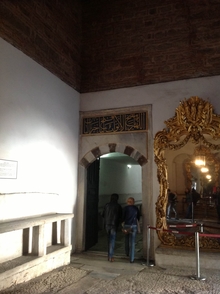Our start to the day was much more relaxed than our first day in Istanbul. The jetlag, unfortunately, is definitely making itself known amongst the group. Some of us had a little trouble adjusting to the time difference last night—a couple of us were wide awake at 7, 6, even 5am. Being awake at that hour definitely had its benefits, though, as I was able to hear the call to prayer for salat al-fajr, or “prayer of the dawn.” It was a beautiful thing to hear during the sacred stillness that is so characteristic of the early hours of dawn. Indeed, it’s the degree of religiosity here in Istanbul that has struck me the most since arriving.
We all had breakfast together, and then went on to have a brief but very informative history of Turkey session with Professor Khan. Our day consisted of visiting various sites, including the iconic Hagia Sofia. Initially a basilica, and later a mosque, the structure is now a museum serving secular purposes. I found this transition, from Christian-to Muslim-to secular, fascinating. The Hagia Sofia, in a way, serves as a symbol that reflects the history of religions in Turkey; it has shifted in purpose across time, each time to better match with the society’s specific cultural identity within a particular epoch. One of the most curious features of the Hagia Sophia is its seemingly disparate architectural/aesthetic components. When one enters the structure, one immediately notices the giant, wooden plaques adorned with beautiful Arabic script bearing the names of the Prophet and of Allah, all juxtaposed with Byzantine-era depictions of Christ and other Christian imagery. The literal coexistence of the two religions, all under one unified space, is truly something special that must be witnessed in person. Here’s a little preview:
Later in the day we visited Topkapi palace, the famous residence of the Ottoman sultans for over 400 years of their 600+ year reign. The opulence and grandeur with which the sultans lived is evident as soon as one sets foot on the grounds—beautiful, elaborate fountains and buildings peppered over broad expanses of land. We visited the harem of the palace, a space that contained more than 400 rooms made to accommodate the numerous concubines and wives of the sultan. The harem seemed to be a palace in its own right, as it contained pools, long winding corridors, and numerous elaborately decorated bedrooms. See the pictures at the bottom of this post to get a better idea of the harem.
It was interesting to see, both in the Hagia Sophia and at Topkapi, the Arabic script previously used by Turks juxtaposed by the modern Turkish-Latinate script. I often found that my attention at these sites was immediately drawn to the decorative Arabic script quoting verses of the Qur’an—however, the consistency of this moment was broken by the presence of informative plaques written in modern Turkish script. Noticing this reminded me of the brief history lesson our group had with Professor Khan, particularly of the moment in which she discussed the recent re-imagining of the Turkish identity by virtue of the Latinate script. It seems that the Latinate script was developed and institutionalized in an attempt at re-imagining the collective Turkish identity in a euro-centric way. This search for and reconciliation of identities fascinates me, as it is something with which all human beings can identify. It is very much a part of the human condition to grapple with the fundamental question: “who am I?”, and it was especially great to find something with which I can relate in a place that is ~5,000 from home.
Thanks for reading!
Will





